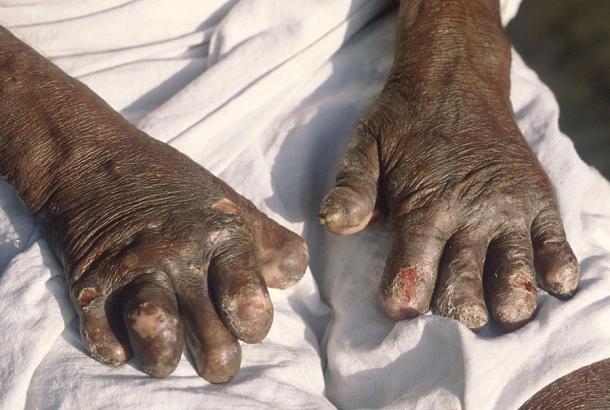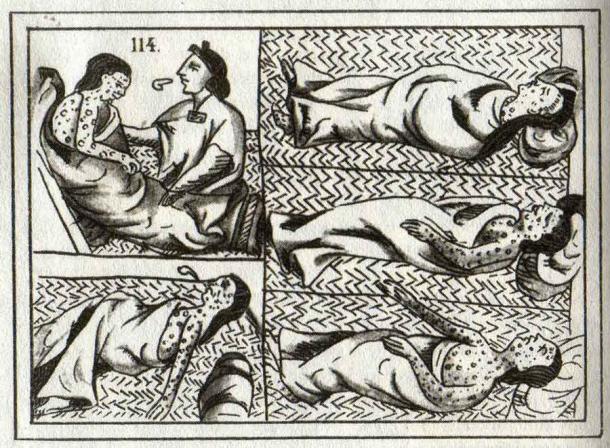A ground-breaking recent leprosy research study published in the International Journal of Paleopathology used the fragments of a skull found on an uninhabited Caribbean island called Petite Musique to reveal more about this Biblical disease. Using radiocarbon dating, the study proved the existence of leprosy in the Caribbean roughly 200 years ago. What makes this find particularly unique is that the skull is only one of a handful of examples of leprosy identified on a skeleton in the Western Hemisphere, writes Phys. The Caribbean leprosy skull was first discovered in 2003.
A Brief History of Leprosy
The team, led by University of Oregon Professor Scott M. Fitzpatrick, noted how they deviated from the norm by assessing the skull itself, rather than estimating age using nearby artifacts and materials. Leprosy has been an elusive subject in the Caribbean and documentation of the disease only began in the mid-17th century AD. Until now the evidence of leprosy in the region was minimal, with scant skeletal evidence to show a pattern or a spread in the disease.
Some historical records suggest a leprosarium, isolationist, hospital-like spaces where lepers were exiled from society to prevent the spread of the lethal disease, existed in the region in the early 1800s.

Hands deformed by leprosy. (B.jehle / CC BY-SA 3.0 )
Leprosy is a medical condition that causes dramatic disfigurement of the hands, feet, and face. These changes also leave a trace in the bones of the patients, reports News Americas Now .
“There are a number of pretty well-known cases in the Caribbean and Pacific where smaller islands were used as places to segregate people with leprosy, such as Molokai in Hawaii,” said Fitzpatrick, who is also the associate director for research at the Museum of Natural and Cultural History in Eugene, Oregon.
Leprosy has had a long history of affecting humanity, dating back thousands of years. It is caused by a mycobacteria that can be transmitted from a person affected by leprosy to another human being. However, in the majority of cases, almost 95%, this does not necessarily cause infection.
Leprosy was mentioned by Hippocrates, a Greek physician in the Age of Pericles, in 460 BC. There has also been unconfirmed evidence of the disease in the ancient Indus civilization . Most experts believe that the disease came from Africa . Over the course of the last few decades, the incidence, spread, and transmission of leprosy have drastically fallen all over the world.

Sixteenth-century Aztec drawings of victims of smallpox, which like leprosy, was something that was brought from the Old World to the New World by European colonizers. ( Public domain )
The Columbian Exchange and The Transfer of Diseases
The recent research study focuses on the Columbian Exchange, in reference to the conquistador Christopher Columbus, which is defined as things brought to the New World and also things that came from the New World. For example, coffee, tobacco, potatoes, and chocolate were new commodities from the New World that became enormously important in the Old World. The Columbian Exchange didn’t just occur in the Americas. The term also covers things that went to or came from Asia and Africa.
Part of the exchange also involved diseases. Venereal syphilis, a sexually transmitted disease , came to Europe from the New World. And one of the most devastating effects of the colonization of the Americas were diseases that came from the Old World, which the indigenous populace had no immunity against. These include measles, smallpox, and typhus, which wiped out huge numbers of the indigenous populations in the Americas within years of the arrival of the Europeans in the New World.

Evidence of leprosy in the nasal area of the Caribbean skull found on the uninhabited island of Petite Mustique and used in the recent study. ( International Journal of Paleopathology )
Research Methodology and Finds
For a long time, leprosy was believed to have existed in the Americas before the Europeans arrived. However, the new study has shown conclusive evidence that leprosy was transferred from the Old World to the New World.
Leprosy was widespread during the colonial period in the Caribbean, especially by the mid-17th century AD. The disease spread with the European-directed transatlantic slave trade, when millions of Africans slaves were sent across the Atlantic to work on agricultural plantations, which produced enormous profits for the European colonizers of the New World.
There is no archaeological record of leprosy existing in the Americas prior to European contact, which makes it certain that leprosy was one of several diseases that journeyed across the Atlantic with the Europeans.
Lead author and skeletal biologist, Greg Nelson said, “the fact that leprosy can also lead to noticeable disfigurement of the hands, feet and particularly the face made it a very scary disease and likely precipitated moves to isolate people with leprosy.” He was referring to his research methodology wherein leprosy was assessed based on the pattern of skeletal deformation in the nose and upper jaw of the skull found on the uninhabited Caribbean island.
Going forward, the discovery of the leprosy skull will help to unify a complicated and lesser studied variant of sociological and medical history, which so far has been based on a very small number of skeletal finds in the Western Hemisphere.
Top image: It was this skull, found on the uninhabited island of Petite Mustique in the Caribbean, that was used in the recent leprosy research study. Source: International Journal of Paleopathology
By Sahir Pandey
Related posts:
Views: 0
 RSS Feed
RSS Feed

















 November 23rd, 2021
November 23rd, 2021  Awake Goy
Awake Goy  Posted in
Posted in  Tags:
Tags: 
















